Yamaha MU5 User Manual


FCC INFORMATION (U.S.A.)
IMPORTANT NOTICE: DO NOT MODIFY THIS UNIT!
This product, when installed as indicated in the instructions contained in this manual, meets FCC requirements. Modifications not expressly approved by Yamaha may void your authority, granted by the FCC, to use the product.
IMPORTANT:
When connecting this product to accessories and/or another product use only high quality shielded cables. Cable/s supplied with this product MUST be used. Follow all installation instructions. Failure to follow instructions could void your FCC authorization to use this product in the USA.
NOTE:
This product has been tested and found to comply with the requirements listed in FCC Regulations, Part 15 for Class “B” digital devices. Compliance with these requirements provides a reasonable level of assurance that your use of this product in a residential environment will not result in harmful interference with other electronic devices. This equipment generates/uses radio frequencies and, if not installed and used according to the instructions found in the user’s manual, may cause interference harmful to the operation of other electronic devices. Compliance with FCC regulations does not guarantee that interference will not occur in all installations. If this product is found to be the source of interference, which can be determined by turning the unit “OFF” and “ON”, please try to eliminate the problem by using one of the following measures:
•Relocate either this product or the device that is being affected by the interference.
•Utilize power outlets that are on different branch (circuit breaker or fuse) circuits or install AC line filter/s.
•In the case of radio or TV interference, relocate/reorient the antenna. If the antenna lead-in is 300 ohm ribbon lead, change the lead-in to co-axial type cable.
If these corrective measures do not produce satisfactory results, please contact the local retailer authorized to distribute this type of product. If you can not locate the appropriate, please contact Yamaha Corporation of America, Electronic Service Division, 6600 Orangethorpe Ave, Buena Park CA, 90620
• This applies only to products distributed by Yamaha Corporation of America.
CANADA
THIS DIGITAL APPARATUS DOES NOT EXCEED THE “CLASS B” LIMITS FOR RADIO NOISE EMISSIONS FROM DIGITAL APPARATUS SET OUT IN THE RADIO INTERFERENCE REGULATION OF THE CANADIAN DEPARTMENT OF COMMUNICATIONS.
LE PRESENT APPAREIL NUMERIQUE N’EMET PAS DE BRUITS RADIOELECTRIQUES DEPASSANT LES LIMITES APPLICABLES AUX APPAREILS NUMERIQUES DE LA “CLASSE B” PRESCRITES DANS LE REGLEMENT SUR LE BROUILLAGE RADIOELECTRIQUE EDICTE PAR LE MINISTERE DES COMMUNICATIONS DU CANADA.
*This applies only to products distributed by Yamaha Canada Music LTD.
*Ceci ne s’applique qu’aux produits distribués par Yamaha Canada Music LTD.

Dit produkt is gefabriceerd in overeenstemming met de radiostoringsvoorschriften van de Richtlijn van de Raad (82/499/EEG).
ΑΥΤΗ Η ΣΥΣΚΕΥΗ ΑΝΤΑΠΟΚΡΙΝΕΤΑΙ ΣΤΙΣ ΑΠΑΙΤΗΣΕΙΣ ΤΩΝ Ο∆ΗΓΙΩΝ ΤΗΣ ΕΥΡΩΠΑΙΚΗΣ ΟΙΚΟΝΟΜΙΚΗΣ ΚΟΙΝΟΤΗΤΑΣ 82/499/Ε.Ο.Κ.
Este produto está de acordo com o radio de interferencia frequente requiridos do Conselho Diretivo 82/499/EEC.
Dette apparat overholder det gaeldende EF-direktiv verdrørende radiostøj.
Cet appareil est conforme aux prescriptions de la directive communautaire 87/308/CEE.
Diese Geräte entsprechen der EG-Richtlinie 82/499/EWG und/oder 87/308/EWG.
This product complies with the radio frequency interference requirements of the Council Directive 82/ 499/EEC and/or 87/308/EEC.
Questo apparecchio è conforme al D.M.13 aprile 1989 (Direttiva CEE/87/308) sulla soppressione dei radiodisturbi.
Este producto está de acuerdo con los requisitos sobre interferencias de radio frequencia fijados por el Consejo Directivo 87/308/CEE.
YAMAHA CORPORATION
Entsorgung leerer Batterien
(nur innerhalb Deutschlands)
Leisten Sie einen Beitrag zum Umweltschutz. Verbrauchte Batterien oder Akkumulatoren dürfen nicht in den Hausmüll. Sie können bei einer Sammelstelle für Altbatterien bzw. Sondermüll abgegeben werden. Informieren Sie sich bei Ihrer Kommune.
The serial number of this product may be found on the bottom of the unit. You should note this serial number in the space provided below and retain this manual as a permanent record of your purchase to aid identification in the event of theft.
Model No. MU5
Serial No.

SPECIAL MESSAGE SECTION (U.S.A.)
This product utilizes batteries or an external power supply (adapter). DO NOT connect this product to any power supply or adapter other than one described in the manual, on the name plate, or specifically recommended by Yamaha.
This product should be used only with the components supplied or; a cart, rack, or stand that is recommended by Yamaha. If a cart, etc., is used, please observe all safety markings and instructions that accompany the accessory product.
SPECIFICATIONS SUBJECT TO CHANGE:
The information contained in this manual is believed to be correct at the time of printing. However, Yamaha reserves the right to change or modify any of the specifications without notice or obligation to update existing units.
This product, either alone or in combination with an amplifier and headphones or speaker/s, may be capable of producing sound levels that could cause permanent hearing loss. DO NOT operate for long periods of time at a high volume level or at a level that is uncomfortable. If you experience any hearing loss or ringing in the ears, you should consult an audiologist. IMPORTANT: The louder the sound, the shorter the time period before damage occurs.
NOTICE:
Service charges incurred due to lack of knowledge relating to how a function or effect works (when the unit is operating as designed) are not covered by the manufacturer’s warranty, and are therefore the owners responsibility. Please study this manual carefully and consult your dealer before requesting service.
ENVIRONMENTAL ISSUES:
Yamaha strives to produce products that are both user safe and environmentally friendly. We sincerely believe that our products and the production methods used to produce them, meet these goals. In keeping with both the letter and the spirit of the law, we want you to be aware of the following:
Battery Notice:
This product MAY contain a small nonrechargeable battery which (if applicable) is soldered in place. The average life span of this type of battery is approximately five years. When replacement becomes necessary, contact a qualified service representative to perform the replacement.
This product may also use “household” type batteries. Some of these may be rechargeable. Make sure that the battery being charged is a rechargeable type and that the charger is intended for the battery being charged.
When installing batteries, do not mix old batteries with new, or with batteries of a different type. Batteries MUST be installed correctly. Mismatches or incorrect installation may result in overheating and battery case rupture.
Warning:
Do not attempt to disassemble, or incinerate any battery. Keep all batteries away from children. Dispose of used batteries promptly and as regulated by the laws in your area. Note: Check with any retailer of household type batteries in your area for battery disposal information.
Disposal Notice:
Should this product become damaged beyond repair, or for some reason its useful life is considered to be at an end, please observe all local, state, and federal regulations that relate to the disposal of products that contain lead, batteries, plastics, etc. If your dealer is unable to assist you, please contact Yamaha directly.
NAME PLATE LOCATION:
The name plate is located on the bottom of the product. The model number, serial number, power requirements, etc., are located on this plate. You should record the model number, serial number, and the date of purchase in the spaces provided below and retain this manual as a permanent record of your purchase.
Model |
MU5 |
Serial No.
Purchase Date
92-BP
PLEASE KEEP THIS MANUAL

Welcome to the MU5
Congratulations and thank you for purchasing the Yamaha MU5 Tone Generator!
The MU5 is an advanced tone generator providing exceptionally high-quality Voices, full General MIDI compatibility, and flexible computer interfacing in a highly compact and portable package.
With the built-in host computer interface and MIDI terminals, the MU5 is ideal for any computer music system — from connection to a simple laptop to integration in a complete MIDI studio. It even features a two-octave keyboard (with adjustable tenoctave range), allowing you to play the internal Voices and enter notes to a connected sequencer. And, since it runs on batteries as well, it’s ready to make music wherever you take it.
■ Trademarks
•Apple and Macintosh are trademarks of Apple Computer, Inc.
•IBM PC and PC/AT are registered trademarks of International Business Machines Corporation.
•PC-9800 Series is a trademark of NEC Corporation.
All other trademarks are the property of their respective holders.
1

Table of Contents
Welcome to the MU5 . . . . . . . . . . . . . . . . . . . . . . . . . . . . . . . . . |
. .1 |
How to Use This Manual . . . . . . . . . . . . . . . . . . . . . . . . . . . . . . |
. .4 |
Precautions . . . . . . . . . . . . . . . . . . . . . . . . . . . . . . . . . . . . . . . . |
. .6 |
The Controls of the MU5 . . . . . . . . . . . . . . . . . . . . . . . . . . . . . . |
. .8 |
■ Front Panel . . . . . . . . . . . . . . . . . . . . . . . . . . . . . . . . . |
. .8 |
■ Rear Panel . . . . . . . . . . . . . . . . . . . . . . . . . . . . . . . . . . |
.10 |
■ Side Panel . . . . . . . . . . . . . . . . . . . . . . . . . . . . . . . . . . |
.10 |
The MU5 — What It Is and What It Can Do . . . . . . . . . . . . . . . . . |
11 |
Setting Up Your MU5 . . . . . . . . . . . . . . . . . . . . . . . . . . . . . . . . . |
.14 |
■ Power Supply . . . . . . . . . . . . . . . . . . . . . . . . . . . . . . . . |
.14 |
● Using a Power Adaptor . . . . . . . . . . . . . . . . . . . |
. 14 |
● Using Batteries . . . . . . . . . . . . . . . . . . . . . . . . . |
.15 |
● When to Replace the Batteries . . . . . . . . . . . . . |
. 15 |
■ Audio Connections . . . . . . . . . . . . . . . . . . . . . . . . . . . . |
.16 |
● Using Headphones . . . . . . . . . . . . . . . . . . . . . . |
. 16 |
● Using an External Sound System . . . . . . . . . . . |
. 16 |
Setting Up the MU5 in Your Music System . . . . . . . . . . . . . . . . |
. 17 |
■ Connecting With a Computer . . . . . . . . . . . . . . . . . . . . |
. 17 |
● Macintosh . . . . . . . . . . . . . . . . . . . . . . . . . . . . . |
.18 |
● IBM PC and Clones . . . . . . . . . . . . . . . . . . . . . . |
. 19 |
● NEC PC-9800 Series . . . . . . . . . . . . . . . . . . . . . |
.20 |
■ Connecting to Other MIDI Devices . . . . . . . . . . . . . . . |
.20 |
■ Data Flow Block Diagram . . . . . . . . . . . . . . . . . . . . . . |
. 21 |
■ MIDI/Computer Connecting Cables . . . . . . . . . . . . . . . |
.22 |
Playing the Demo Song . . . . . . . . . . . . . . . . . . . . . . . . . . . . . . . |
.23 |
Using the MU5 — The Play Mode . . . . . . . . . . . . . . . . . . . . . . . . |
24 |
■ Playing the Keyboard . . . . . . . . . . . . . . . . . . . . . . . . . . |
. 24 |
■ Changing the Octave Setting . . . . . . . . . . . . . . . . . . . . |
. 25 |
■ Selecting a Part and Changing the Voice . . . . . . . . . . |
. 26 |
Using the MU5 with a Computer or Sequencer . . . . . . . . . . . . . |
. 28 |
Using the MU5 with a MIDI Data Storage Device . . . . . . . . . . . |
. 28 |
Muting and Soloing Parts . . . . . . . . . . . . . . . . . . . . . . . . . . . . . . |
.29 |
Editing . . . . . . . . . . . . . . . . . . . . . . . . . . . . . . . . . . . . . . . . . . . . |
.30 |
2

Table of Contents 
Reference . . . . . . . . . . . . . . . . . . . . . . . . . . . . . . . . . . . . . .32
Utility Mode . . . . . . . . . . . . . . . . . . . . . . . . . . . . . . . . . . . . . . . . . |
32 |
● Master Tune . . . . . . . . . . . . . . . . . . . . . . . . . . . . . |
32 |
● Transpose . . . . . . . . . . . . . . . . . . . . . . . . . . . . . . |
33 |
● Mute Lock . . . . . . . . . . . . . . . . . . . . . . . . . . . . . . |
33 |
● Velocity . . . . . . . . . . . . . . . . . . . . . . . . . . . . . . . . |
34 |
● Local Control . . . . . . . . . . . . . . . . . . . . . . . . . . . . |
35 |
● Dump Out . . . . . . . . . . . . . . . . . . . . . . . . . . . . . . |
36 |
● Initialize All . . . . . . . . . . . . . . . . . . . . . . . . . . . . . . |
38 |
Part Edit Mode . . . . . . . . . . . . . . . . . . . . . . . . . . . . . . . . . . . . . . . |
39 |
● Volume . . . . . . . . . . . . . . . . . . . . . . . . . . . . . . . . . |
39 |
● Pan . . . . . . . . . . . . . . . . . . . . . . . . . . . . . . . . . . . |
40 |
● MIDI Channel . . . . . . . . . . . . . . . . . . . . . . . . . . . . |
40 |
● Note Shift . . . . . . . . . . . . . . . . . . . . . . . . . . . . . . . |
41 |
● Part Tune . . . . . . . . . . . . . . . . . . . . . . . . . . . . . . . |
41 |
● Pitch Bend Range . . . . . . . . . . . . . . . . . . . . . . . . |
42 |
Appendix . . . . . . . . . . . . . . . . . . . . . . . . . . . . . . . . . . . . . .43
Troubleshooting . . . . . . . . . . . . . . . . . . . . . . . . . . . . . . . . . . . . . .43
Error Messages . . . . . . . . . . . . . . . . . . . . . . . . . . . . . . . . . . . . . .45
Specifications . . . . . . . . . . . . . . . . . . . . . . . . . . . . . . . . . . . . . . . .46
Index . . . . . . . . . . . . . . . . . . . . . . . . . . . . . . . . . . . . . . . . . . . . . .47
Voice List . . . . . . . . . . . . . . . . . . . . . . . . . . . . . . . . . . . . . . . .add-2
MIDI Data Format . . . . . . . . . . . . . . . . . . . . . . . . . . . . . . . . . .add-8
MIDI Implementation Chart . . . . . . . . . . . . . . . . . . . . . . . . . .add-24
3

How to Use This Manual
You are probably eager to try out your new MU5 Tone Generator right away and hear what it can do, rather than have to read through a lot of instructions before you can even get a sound out of it.
However, to get the most out of your MU5, we strongly suggest that you read the following sections in the order given:
1) Precautions
This gives you important information on how to care for your new MU5, how to avoid damaging, and how to ensure long-term, reliable operation.
2) The MU5 — What It Is and What It Can Do
This briefly provides an overview of the functions and features of the MU5 and offers some important hints on how you can use it effectively.
3) Setting Up Your MU5; The Controls of the MU5
The first section shows you how to set up your MU5 for basic operation, and the second introduces you to the panel controls and connectors.
4) Playing the Demo Song; Using the MU5 — The Play Mode
These two sections get you started using the MU5. The first guides you through the Demo Song, while the second gives you the basic operation procedures you’ll be using when you play the MU5.
5)Setting Up the MU5 in Your Music System; Using the MU5 with a Computer or Sequencer
These sections provide all you need to know to effectively integrate the MU5 into your present computer music system.
4

How to Use This Manual 
6) Muting and Soloing Parts; Editing
Mute and Solo are useful in song playback, while editing operations prepare you for digging in deeper to the advanced functions of the MU5.
7) Reference
Once you’re familiar with everything above, lightly go over this comprehensive guide to all editing functions. You won’t need (or want) to read everything at once, but it is there for you to refer to when you need information about a certain feature or function.
8) Appendix
Finally, use the sections in the Appendix as necessary. For example, the Index will come in handy when you need to quickly find information on a specific topic. Other sections, such as the
Voice List, Troubleshooting and Error Messages provide additional useful information.
5

Precautions
Your MU5 will give you years of reliable service if you follow the simple precautions below:
● LOCATION
Keep the instrument away from locations where it is likely to be exposed to high temperatures (such as direct sunlight) or humidity. Also avoid locations which are subject to excessive dust accumulation or vibration which could cause mechanical damage.
● USE THE CORRECT POWER ADAPTOR
Use only the recommended PA-3, PA-4 or PA-40 Power Adaptor for supplying power to the instrument. Use of another adaptor may cause serious damage to the instrument or the adaptor itself. (Never use the PA-3B.)
● MAKE SURE POWER IS OFF WHEN MAKING OR
REMOVING CONNECTIONS
To prevent damage to the instrument and other connected equipment, always turn off the power prior to connecting or disconnecting cables. Also, turn the power off when the instrument is not in use, and disconnect the power adaptor during electric storms.
● HANDLE THE INSTRUMENT WITH CARE
Although the instrument has been constructed to withstand the rigors of normal use for optimum sturdiness and reliability, avoid subjecting it to strong physical shocks (such as dropping or hitting it). Since the MU5 is a precision-made electronic device, also avoid applying excessive force to the various controls. When moving the instrument, first unplug the power adaptor and all other cables to prevent damage to cords and jacks. Always unplug cables by gripping the plug firmly, not by pulling on the cable.
6

Precautions 
● CLEAN WITH A SOFT, DRY CLOTH
Never use solvents such as benzine or thinner to clean the instrument, since these will damage the cabinet finish or dull the keys. Wipe clean with a soft, dry cloth. If necessary, use a soft, clean, slightly moistened cloth — making sure to wipe the case off again with a dry cloth.
● ELECTROMAGNETIC INTERFERENCE
Avoid using the unit near televisions, radios or other equipment generating electromagnetic fields. Proximity to such equipment may cause the unit to malfunction, and may generate interference noise in the other appliance as well.
● DO NOT OPEN THE CASE OR TRY REPAIRING
THE INSTRUMENT YOURSELF
The instrument contains no user-serviceable parts. Never open the case or tamper with the internal circuitry in any way, since doing so may result in damage to the instrument. Refer all servicing to qualified Yamaha service personnel.
● MIDI CABLES
When connecting the instrument to other MIDI equipment, be sure to use only high-quality cables made especially for MIDI data transmission. Also, avoid using cables longer than 15 meters, since long cables can result in data errors.
Yamaha is not responsible for damage caused by improper handling or operation.
7
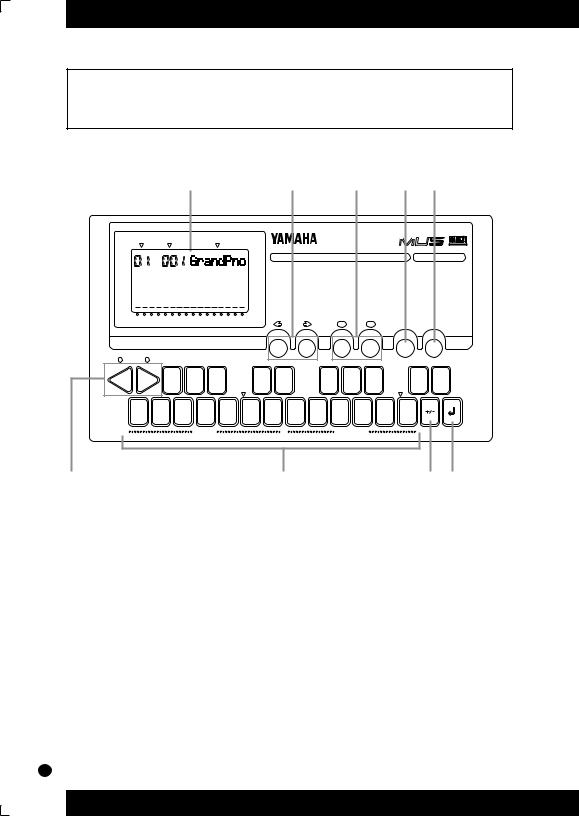
|
|
The Controls of the MU5 |
|||||||||||||||||||
■ Front Panel |
|
|
|
|
|
|
|
|
|
|
|
|
|
||||||||
|
|
|
|
|
|
|
|
q |
|
|
|
w |
|
|
|
e |
|
r |
|
t |
|
|
|
|
|
|
|
|
|
|
|
|
|
|
|
|
|
|
|
|
|
|
G E N E R A L |
|
PART |
|
|
PGM# |
|
VOICE NAME |
|
|
|
|
|
|
TONE GENERATOR |
|
|
||||||
|
|
|
|
|
|
|
|
|
|
|
|
VOICE LIST |
|
|
|
|
|
|
DRUM VOICE LIST |
||
|
|
|
|
|
|
|
|
|
|
|
|
001 |
–008 PIANO |
|
065–072 REED |
|
1 2 9 |
STANDARD |
|||
|
|
|
|
|
|
|
|
|
|
|
|
009 |
–016 TUNED PERC. |
073–080 PIPE |
|
1 3 0 |
ROOM |
||||
|
|
|
|
|
|
|
|
|
|
|
|
017 |
–024 ORGAN |
|
081–088 SYNTH LEAD |
1 3 1 |
ROCK |
||||
|
|
|
|
|
|
|
|
|
|
|
|
025 |
–032 GUITAR |
|
089–096 SYNTH PAD |
1 3 2 |
ELECTRONIC |
||||
|
|
|
|
|
|
|
|
|
|
|
|
033 |
–040 BASS |
|
097–104 SYNTH EFFECTS |
1 3 3 |
ANALOG |
||||
|
|
|
|
|
|
|
|
|
|
|
|
041 |
–048 STRINGS |
|
105 –112 ETHNIC |
|
1 3 4 |
JAZZ |
|||
|
|
|
|
|
|
|
|
|
|
|
|
049 |
–056 ENSEMBLE |
|
113 –120 PERCUSSIVE |
1 3 5 |
BRUSH |
||||
|
|
|
|
|
|
|
|
|
|
|
|
057 |
–064 BRASS |
|
121 –128 SOUND EFFECTS |
1 3 6 |
CLASSIC |
||||
|
1 |
2 |
3 |
4 |
5 |
6 |
7 |
8 |
9 10 1112 13 14 1516 |
|
PART |
|
|
–1 VALUE +1 |
MUTE |
|
EXIT |
||||
|
|
|
|
|
|
|
|
|
|
|
|
|
|
|
|
||||||
SELECT |
|
|
|
|
|
|
|
|
|
|
|
|
|
|
|
|
|
|
|
|
|
OCT |
OCT |
|
|
|
1 |
|
|
2 |
3 |
4 |
5 |
6 |
|
|
7 |
8 |
|
9 |
0 |
||
DOWN |
UP |
|
|
|
|
|
|
|
|
||||||||||||
|
|
|
|
|
|
|
|
|
|
|
|
|
|
|
|
|
|
|
|||
|
|
|
|
|
|
|
|
|
|
|
C |
|
|
|
|
|
|
|
C |
|
|
|
MSTR |
|
TRNS |
|
MUTE |
VELO |
LOCL |
DUMP |
INIT |
VOL |
PAN |
MIDI |
NOTE |
PART |
BEND |
|
|
||||
|
TUNE |
|
POSE |
|
LOCK |
CITY |
CTRL |
OUT |
ALL |
CH |
SHFT |
TUNE |
RNGE |
|
|
||||||
|
|
|
|
|
|
|
|||||||||||||||
|
|
|
|
|
|
|
|
|
UTILITY |
|
|
|
|
|
|
PART EDIT |
|
|
|
ENTER |
|
y |
|
|
|
|
|
|
|
|
|
|
|
u |
|
|
|
|
|
|
i o |
||
q Display
In the Play mode, this shows the Part number and the currently selected program number and Voice name for the Part. It also shows the octave setting (when set to a value other than normal) and acts as a “level meter,” showing the velocity values for each Part as they are played.
In the Edit modes, this shows the relevant values and, where applicable, a graphic display of the set values.
w ,.buttons
For selecting the desired Part. (In some of the Edit functions, these may not be available.) Hold down either button to rapidly advance through the values.
8

The Controls of the MU5 
e -=buttons
For changing the value of the selected function or parameter. In the Play mode, these are used to change the program number at the selected Part. In the Edit modes, these are used to change the current function’s value or turn a function on or off. Hold down either button to rapidly advance through the values.
r mbutton
For using the Mute and Solo functions. (See page 29.)
t ebutton
For leaving the Edit modes and returning to the Play mode.
y d(OCTAVE DOWN) and u(OCTAVE UP) buttons
For changing the octave transposition of the MU5’s keyboard. These also double as sbuttons, allowing you to select the functions of the Edit modes.
u Keyboard
This two-octave keyboard is used to play the Voices of the MU5. It can also be used to play notes on a connected external tone generator or enter notes to a connected sequencer or computer.
The white keys double as editing controls, while the black keys also function as number keys. (Used with the sbuttons.)
i /button
For switching between positive (+) and negative (-) values during editing. (Used with the sbuttons.)
o Ebutton
For actually entering values during editing. (Used with the sbuttons.)
9
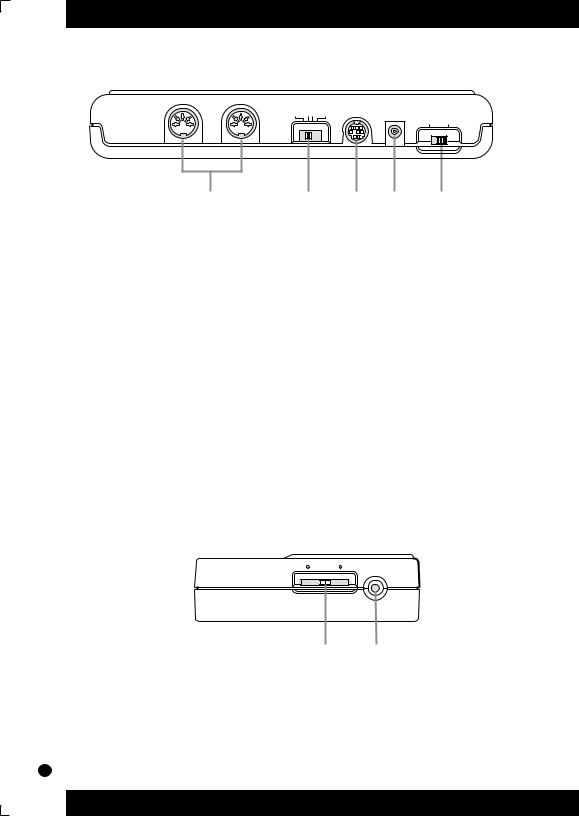
■ Rear Panel
OUT |
|
MIDI |
|
IN |
|
|
HOST SELECT |
|
|
MIDI PC-2 PC-1 Mac TO HOST |
DC IN |
POWER |
|
|
ON OFF |
q w e r t
q MIDI OUT and MIDI IN terminals
For connection to other MIDI devices, such as a MIDI keyboard, tone generator, sequencer, or to a computer that has a MIDI interface. (See page 20.)
w HOST SELECT switch
For selecting the type of connected device. (See pages 17 – 20.)
e TO HOST terminal
For connection to a host computer that does not have a MIDI interface. (See pages 17 – 20.)
r DC IN jack
For connection to the AC power adaptor.
t POWER switch
For turning on the power to the unit.
■ Side Panel
MIN VOLUME MAX LINE OUT/
PHONES
q w
q VOLUME control
For adjusting the overall level of the MU5.
w LINE OUT/PHONES jack
For connection to an amplifier/speaker system or a set of stereo headphones.
10

The MU5 — What It Is and What It Can Do 
The MU5 — What It Is and What It Can Do
■ What It Is...
The MU5 is a compact, highly portable and easy-to-use tone generator. It features full General MIDI Level 1 compatibility with 128 General MIDI Voices and 8 drum kits. The MU5 has 28-Voice polyphony and is 16-Part multi-timbral. In other words, the MU5 has 16 different Parts, each with its own Voice, so that up to 16 different Voices can be sounded simultaneously.
With the built-in two-octave keyboard, you can play any of the Voices directly from the MU5 itself. Or you can play them from a connected MIDI keyboard. In addition, the MU5 also has a TO HOST terminal for easy interfacing with a computer, allowing you to play the Voices using your favorite music software. This is where the advanced multi-timbral capabilities come in, letting you play up to 16 different Voices at the same time.
■ About General MIDI
General MIDI is a new addition to the worldwide MIDI standard. MIDI, as you know, stands for Musical Instrument Digital Interface, and makes it possible for various electronic musical instruments and other devices to “communicate” with each other. For example, by connecting a sequencer to the MU5’s MIDI IN terminal, you could play back a song on the sequencer using the Voices of the MU5.
So, where does General MIDI fit in all of this? One of the most important features of General MIDI is in the standardization of Voices. This means that a song recorded in the General MIDI format can be played back on any General MIDI compatible tone generator and sound just as the composer intended. For example, if there is an alto sax solo in the song, it will be played by an alto sax Voice on the General MIDI tone generator (and not by a tuba or harpsichord!). Since the MU5 is fully compatible with General MIDI, you can take advantage of the vast wealth of musical material recorded in that format.
11

■ What It Can Do...
Here are a few ideas on how you can use the MU5. The list below is not comprehensive, but is meant to be a general guide to the possibilities and provide a starting point or springboard for your own creative ideas and explorations.
● Using With MIDI Keyboard
Use the MU5 as supplementary tone generator with your MIDI keyboard and play the Voices of both instruments in a layer together. Or, if your keyboard has the capability, program a “split” so that the notes you play on the right side of the keyboard play only the Voices of the MU5.
● Using With Other MIDI Controllers
Even if you’re not a keyboard player, you can still play the MU5 with other types of MIDI controllers. For example, you can use a MIDI percussion controller to play the drum and percussion sounds of the MU5.
■When Connected to a Computer or Sequencer
● Home Studio Setup
The MU5 integrates easily into any existing setup. If you have a MIDI keyboard, computer and sequencing software, the MU5 with its high-quality Voices and multi-timbral capabilities can expand your home studio system.
● Carry It With You
If you have a laptop computer (and sequencing software), simply connect the MU5, plug in some headphones and you’ve got a complete music making system that’s ready to go wherever you go. Use it for composing, arranging, practicing or making/ playing demos for your band.
12

The MU5 — What It Is and What It Can Do 
● Perform With It
Bring it with you to a gig — as long as there’s a MIDI keyboard on stage, you can use the high-quality sounds of MU5 in your performance.
● Multimedia
Since it’s portable and compatible with General MIDI, the MU5 is a natural for multimedia applications. Bring it with you to a presentation — since the computer interface is built-in to the MU5, it hooks up instantly and easily to the computer’s serial port or printer port, without the need for any other equipment.
■ About the Modes of the MU5
The MU5 has three operating modes: Play, Utility and Part Edit. (Utility and Part Edit are the two edit-related modes of the MU5.)
● Play Mode
This is the normal mode of the MU5, the one in which you normally play and select the internal Voices (either from the built-in keyboard or a connected MIDI device), select Parts, and use the Mute and Solo functions.
● Utility Mode
The Utility mode lets you set functions related to the overall operation of the MU5, such as Master Tune, Transpose and Velocity settings. Included also are utility operations, such as sending bulk data to a data storage device, and initializing of the MU5 settings.
● Part Edit Mode
The Part Edit mode allows you to change certain settings for each individual Part, such as the Volume, Pan and individual tuning settings for each Part. The internal Voices can be sounded during editing, allowing you to hear the effects of your edits.
13
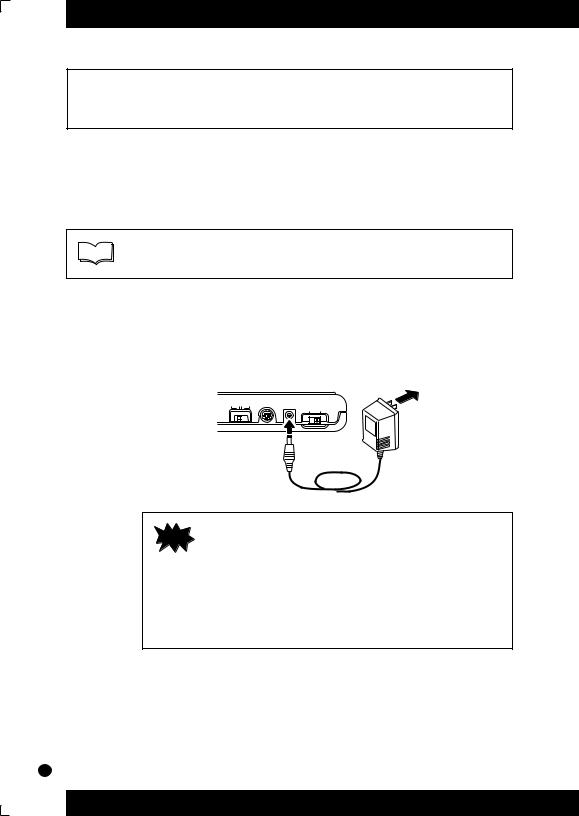
Setting Up Your MU5
■ Power Supply
Your MU5 will run either from an optional AC adaptor or batteries. Follow the instructions below according to the power source you intend to use.
Before making any connections, make sure that all equipment to
NOTE
be connected is turned off.
● Using a Power Adaptor
Connect one end of the power adaptor (Yamaha PA-3, PA-4 or PA-40) to the DC IN jack on the rear panel, and the other end to a suitable electrical outlet.
HOST SELECT |
|
|
MIDI PC-2 PC-1 Mac TO HOST |
DC IN |
POWER |
|
|
ON OFF |
AC adaptor
■ Do not attempt to use an AC adaptor other than
CAUTION!
the PA-3, PA-4 or PA-40. The use of an incompatible adaptor may result in irreparable damage to the MU5, and even pose a serious shock hazard.
(Never use the PA-3B.)
■ Be sure to disconnect the power adaptor from the outlet when the MU5 is not in use.
14
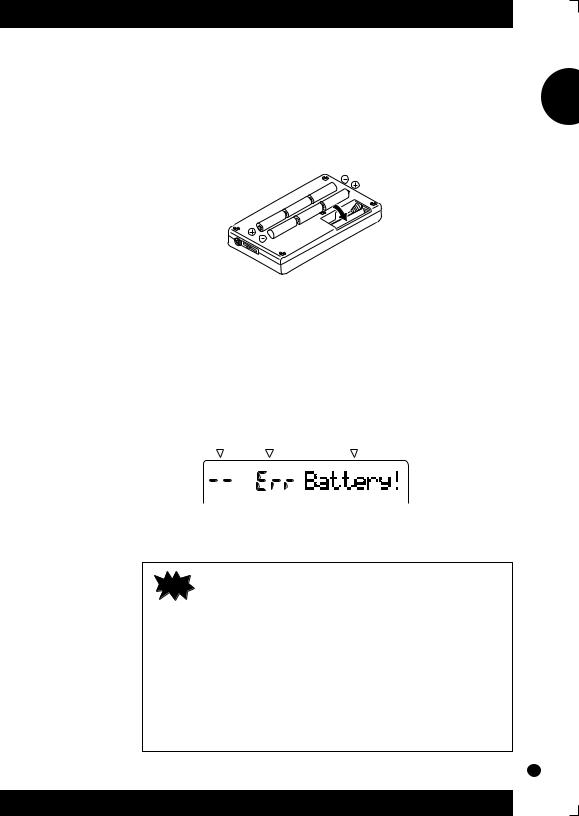
Setting Up Your MU5 
● Using Batteries
To use the MU5 on battery power, insert six 1.5V AA size (SUM-3, R-6 or equivalent) manganese or alkaline batteries in the battery compartment. Make sure to follow the polarity indications on the bottom case (and as shown below).
Securely replace the battery compartment cover when done installing the batteries.
● When to Replace the Batteries
When the battery power runs too low to operate the MU5, the following display will appear:
PART PGM# |
VOICE NAME |
When this happens, replace all batteries with a complete set of six new batteries of the same type.
■ In order to avoid losing any important memory
CAUTION!
settings when battery power becomes low, turn off the MU5, then immediately connect a power adaptor (to supply continuous power) and replace all batteries.
■ NEVER mix old and new batteries or different types of batteries! Also, to prevent possible damage due to battery leakage, remove the batteries from the instrument if it is not to be used for an extended period of time.
15

■ Audio Connections
In order to hear your MU5, you’ll have to make certain audio connections. You can listen to the MU5 by using a set of stereo headphones or by connecting it to an amplifier/speaker system.
● Using Headphones
Connect a set of stereo headphones (with a stereo miniature plug) to the LINE OUT/PHONES jack.
MIN VOLUME MAX LINE OUT/
PHONES
Headphones
● Using an External Sound System
Connect the LINE OUT/PHONES jack on the MU5 to the stereo inputs of an amplifier/speaker system by using a “Y” cable (stereo miniature plug to dual RCA pin plugs), available from many audio and musical instrument dealers.
MIN VOLUME MAX LINE OUT/
PHONES
16

Setting Up the MU5 in Your Music System 
Setting Up the MU5 in Your Music System
As you learned in the section The MU5 — What It Is and What It Can Do on page 11, the MU5 can be integrated into a variety of setups. It would be impossible to cover all connection possibilities in a short manual as this; however, the section below will help in quickly setting up the MU5 and using it in your system.
■ Connecting With a Computer
The MU5 features a built-in host computer interface, allowing you to directly connect it to your computer — eliminating the need of installing a special MIDI interface to your computer. The MU5 can be used with the following computers: Apple Macintosh, IBM PC and the NEC PC-9800 Series.
If your computer has a MIDI interface you may want to connect the MU5 to it, rather than using the host computer interface on the MU5. (See the section “Connecting to Other MIDI Devices” on page 20.)
Depending on the computer or interface used, set the HOST SELECT switch to the appropriate setting: MIDI, PC-1 (NEC computers), PC-2 (IBM and clones), or MAC (Macintosh). For information on the types of cables that can be used for connection, see the section “MIDI/Computer Connecting Cables” on page 22.
17
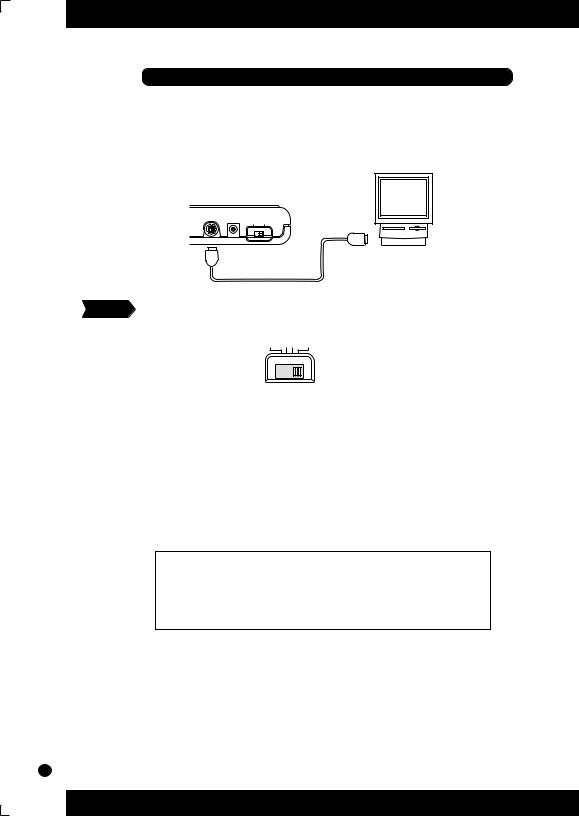
Macintosh
Follow these instructions if you have an Apple Macintosh that is not equipped with an external MIDI interface. Connect the TO HOST terminal on the MU5 to the Modem or Printer port on the Macintosh.
TO HOST |
DC IN |
POWER |
|
|
ON OFF |
Operation 1 Set the HOST SELECT switch to MAC.
HOST SELECT
MIDI PC-2 PC-1 Mac
2 Connect the MU5 to the host computer, as shown in the illustration above. Use a standard Macintosh cable (8-pin Mini DIN on both ends; see page 22).
3
4
Turn on the host computer, then the MU5.
Start up your music software, and set up the appropriate options on the software for operation with the MU5.
● The options you may have to set include:
• MIDI Interface Type |
Standard MIDI Interface |
|
• MIDI Time Piece |
|
Off |
• Clock |
|
1 MHz |
Other options and settings may have to be made as well. Refer to the owner’s manual of your particular music software for more information.
18
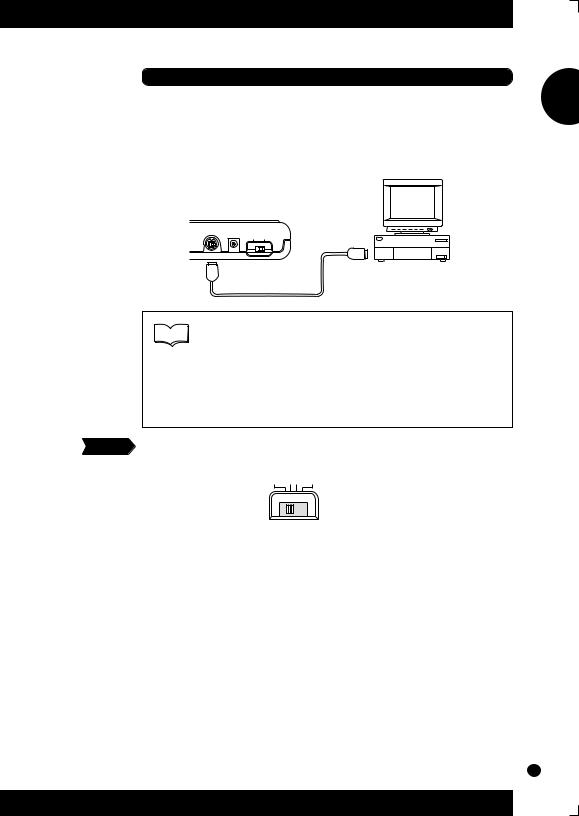
Setting Up the MU5 in Your Music System 
IBM PC and Clones
Follow these instructions if you have an IBM PC/AT or compatible computer that is not equipped with an external MIDI interface. Connect the TO HOST terminal on the MU5 to one of the computer’s serial ports, COM 1 or COM 2.
TO HOST |
DC IN |
POWER |
|
|
ON OFF |
■ Your music software must be able to recognize
NOTE
the TO HOST connection. Consult your Yamaha dealer for more details. If your software is not compatible, you can still use the MU5 by installing a MIDI interface (internal card or external) to the computer.
Operation 1 Set the HOST SELECT switch to PC-2.
HOST SELECT
MIDI PC-2 PC-1 Mac
2 Connect the MU5 to the host computer, as shown in the illustration above. Use a standard computer cable (8-pin Mini DIN to 9-pin D-SUB; see page 22).
3
4
Turn on the host computer, then the MU5.
Start up your music software, and set up the appropriate options on the software for operation with the MU5.
Refer to the owner’s manual of your particular music software for more information.
19
